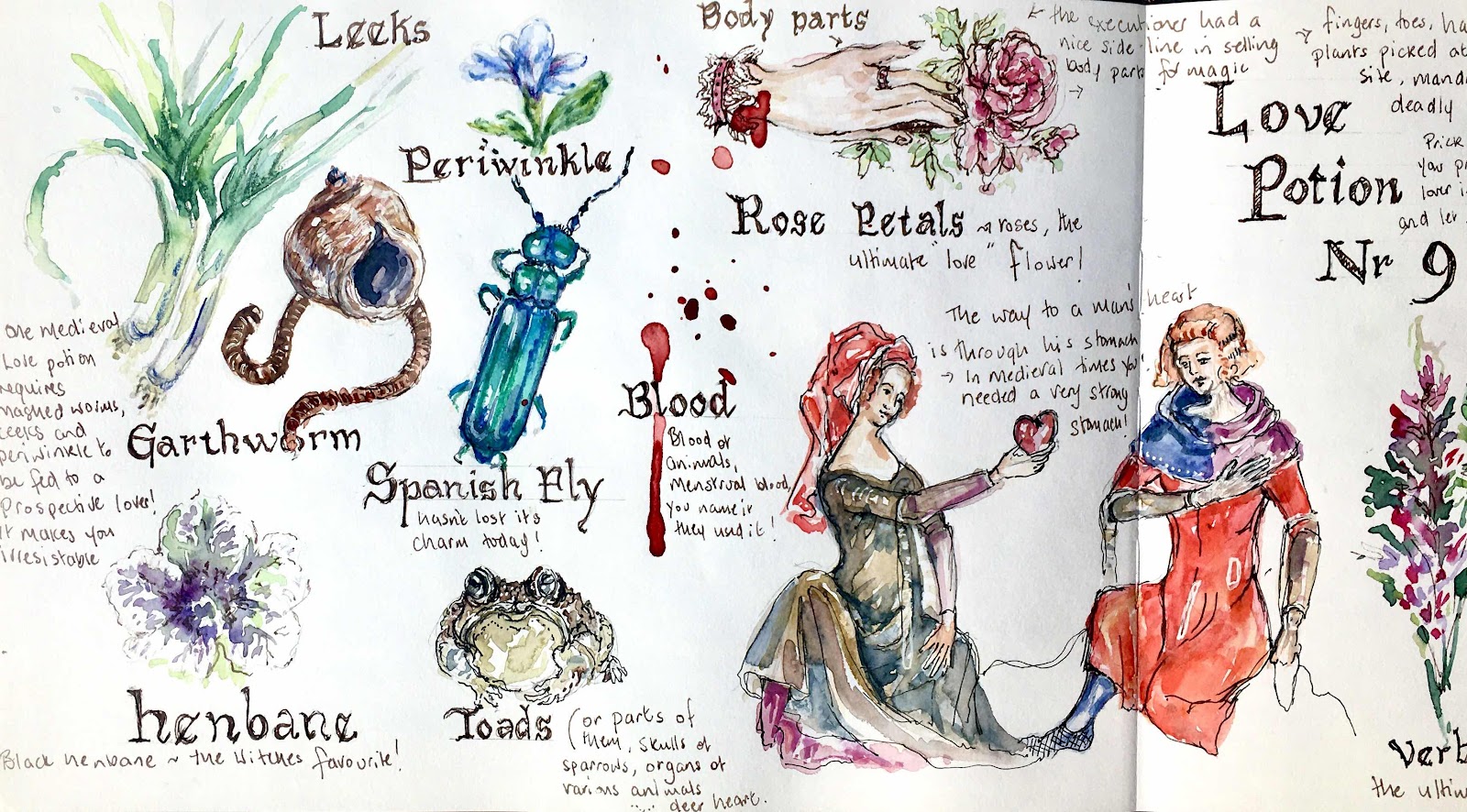Love Potion Number 9
Here’s Love Potion Number 9! If you’re feeling a bit queasy or sensitive today, don’t read on!

 P
P
During my research into witch-hunting in both Scotland and Germany, I read quite a bit about traditional Love magic and this inspired a sketchbook page.
Love magic in history was nothing out of the ordinary and was carried out by Queens, ordinary people and even saints. St Brigid it is said, cast a love spell over a warring couple and was so successful that they couldn’t bear to be parted, not even for an hour. Cunning folk sold love charms, potions and spells as part of daily life and priests were instructed to specifically ask about the use of love magic in the confessional during the 11th and 12th centuries. Love magic was universal and only became a real problem during witch hunting because it implied that the person casting the spell was a witch and the ingredients used were certainly not for the weak of heart.
In a previous post ''Love Cake'', I described how those looking for love baked cakes and rubbed the dough under their armpits, on their buttocks and on their privates before baking the cake and feeding it to their prospective lover. In my sketch my medieval beauty is covering her modesty with a Bavarian love cake. What else did you need to make the perfect love potion, well Vervain/Verbena was definitely on the list of ingredients, the Romans attributed the plant to Venus, for Druids it was a must have and in our Love potion it helps to revive dying love and for brides to be carrying it in your bouquet ensured a passionate wedding night.
Hair, both from your head and pubes were used, blood, sweat and other bodily fluids were also a necessity in our love brew. Not everything was disgusting, roses and rose petals were frequently involved as were honey or mead, not sure that these ingredients could mask the other disgusting components however.
Less appetising was the use of menstrual blood, mixed in red wine it was believed to increase love, lust and fidelity, now that can’t be bad! Unusual ingredients like sparrow tongues, eyes of newts and the bones of toads also enjoyed great popularity, however some believe that these unusual ingredients were a kind of code to keep the true nature of love concoctions or magic potions secret, like ''Blind eyes'' are code for poppies, ''wool of bat'' is moss and ''sparrow's tongue'' is knotweed; these pseudonyms were not only useful to keep secrets but also meant buyers just didn’t go out and pick or plant their own herbs and ingredients, resulting in a loss of business for the cunning folk and herbalists.
Mashed worms, with leeks and periwinkle (not sure whether the plant or the mollusc was meant) was a sure fire way to a lovers heart, yum! Who wouldn’t fall head over heels when fed that for a meal ….. and while we’re feeling squeamish there was also the use of body parts!
Executioners had a nice little side line in selling body parts (fingers, fat, toes, strips of skin (wrapped around your bump while giving birth) penises, bones and teeth), blood and urine also sold well, though spectators were also not averse to hanging (pun intended) at the gallows to get a free drop of blood or waiting to steal the bones after displayed bodies were decomposed. Somehow the executed were believed to be imbued with magical properties and their parts used as amulets, charms and ground for use in love potions.
Finally Henbane, known as the ''Favourite of witches'', Henbane was used in medieval love potions to ''force'' love; hallucinogenic and poisonous, it enjoyed great popularity with the Greeks, Romans, Vikings, Druids and witches. Witches were said to have used it in ''flying ointments'', Henbane causes hallucinations of flying, however there's great discussion among experts about witches' flights; lies or confessions forced by torture? or use of herbal hallucinogens (rubbed into the skin or administrated vaginally or rectally using sticks …. hence the broomstick legend) causing the accused witches to believe that they really had flown. As far fetched as the administration of Henbane, Belladonna and Mandrake with help of a staff/stick to the genitals sounds, it was actually mentioned in an Investigation into Witchcraft in 1324 and by Jordanes de Bergamo in the 15th century; skin irritation could be thus avoided and absorption through membranes is certainly quicker and more effective.
Henbane in Germany certainly enjoyed great popularity in beer …… obviously making the brew more ''intoxicating'', the ''Bavarian beer purity act of 1516'' was supposed to put an end to this practice but there is still records of people getting stocious on beer and Henbane in the 17th &18th century. Called ''Bilsenkraut'' in German, some suggest this is the origin of Pilsner or Pils.
Phew, that was a lot of information to swallow for a page that started out as a bit of fun! So if you’re looking for love or your love is dying you now know what to do! So, I have to fly ……. but without the help of Henbane and a stick!
Comments
Post a Comment